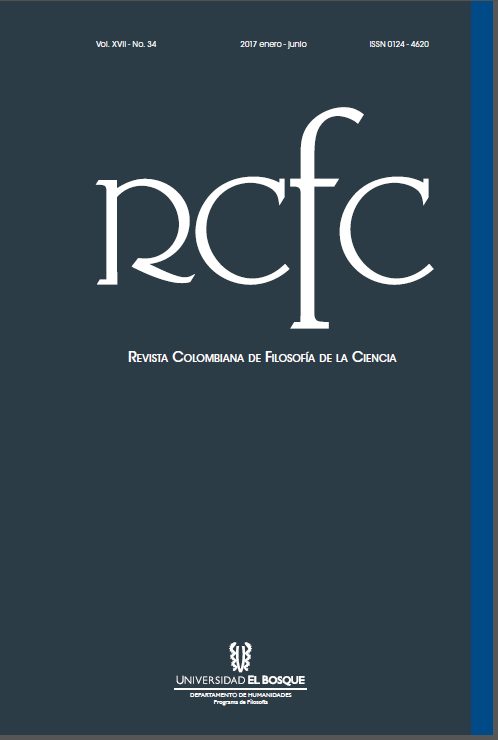Equality, cooperation and territoriality
From Upper Paleolithic bands to contemporary Central American gangs
DOI:
https://doi.org/10.18270/rcfc.v17i34.2083Keywords:
Evolution of cooperation, Youth subcultures, Violence, PleistoceneAbstract
Theories focusing on the repression of incest (Freud, Levi-Strauss) or the social contract (Hobbes, Rousseau) have emphasized the importance of the family and the State, respectively, but have paid little attention to young men’s gangs. The article aims at filling this gap in the literature by analyzing the historical formation of this type of young men’s associations. Building on Boehm’s (1999; 2000a; 2009; 2012), Sterelny’s (2011; 2016), and Marean’s (2016) biological-anthropological theories of the evolution of cooperation that contend that social sanction and conflict resolution were practices that led to the formation of early gangs of hunters-gatherers in the Upper Paleolithic period, the article argues that such structures of social organization still prevail in societies in which gangs and similar groups are as powerful, or more, than other institutions such as the family, chiefdom and even the State itself. In addition, based on ecological models of violence and territoriality, the text shows that from the Pleistocene to the Viking Ages and the Central America criminal crisis, the emergence of gangs and similar groups could be largely explained by a relative scarcity of resources, and are a paradoxical form of cooperative organization.
Downloads
References
Barrett, James H. “What caused the Viking age?” Antiquity 82. 317 (2008): 671-685.
Binmore, Kenneth George. Game theory and the social contract: just playing. Vol. 2. Cambridge: MIT press, 1998.
Boehm, Christopher. “The natural selection of altruistic traits” Human Nature 10.3 (1999): 205-252.
_____ .“The origin of morality as social control” Journal of Consciousness Studies 7.1/2 (2000a): 149-184.
_____ .Interactions of Culture and Natural Selection in the Upper Paleolithic. California: University of Southern California, 2000b.
_____ .Hierarchy in the forest: The evolution of egalitarian behavior. Cambridge: Harvard University Press, 2009.
_____ .Moral origins: The evolution of virtue, altruism, and shame. Nueva York: Basic Books, 2012.
Bowles, Sam & Herbert Gintis. A Cooperative Species: Human Reciprocity and Its Evolution. Princeton: Princeton University Press, 2011.
Brantingham, P. Jeffrey, et al. “The Ecology of Gang Territorial Boundaries”. Criminology 50.3 (2012): 851-885.
Brown, Jerram L. “The evolution of diversity in avian territorial systems” The Wilson Bulletin (1964): 160-169.
Byock, Jesse L. “Governmental Order in Early Medieval Iceland” Viator 17 (1986): 19-34.
Cashdan, Elizabeth, et al. “Territoriality among human foragers: ecological models and an application to four Bushman groups [and Comments and Reply]” Current Anthropology (1983): 47-66.
Chabot‐Hanowell, Benjamin & Eric Alden Smith. “Territorial and Nonterritorial Routes to Power: Reconciling Evolutionary Ecological, Social Agency, and Historicist Approaches” Archeological Papers of the American Anthropological Association 22.1 (2012): 72-86.
Cohen, Stanley. Folk Devils and Moral Panics. The creation of the Mods and Rockers. Londres y Nueva York: Routledge, 2011.
Decker, Scott H. “Collective and normative features of gang violence” Justice Quarterly 13.2 (1996): 243-264.
Decker, Scott H., Charles M. Katz & Vincent J. Webb. “Understanding the black box of gang organization: Implications for involvement in violent crime, drug sales, and violent victimization” Crime & Delinquency 54.1 (2008): 153-172.
Dyson‐Hudson, Rada & Eric Alden Smith. “Human territoriality: an ecological reassessment” American Anthropologist 80.1 (1978): 21-41.
Einarsson, Árni. “Viking Age Fences and Early Settlement Dynamics in Iceland” Journal of the North Atlantic 27 (2015): 1-21.
Flack, Jessica C., & Frans De Waal. “‘Any animal whatever’. Darwinian building blocks of morality in monkeys and apes” Journal of Consciousness Studies 7.1-2 (2000): 1-29.
Freud, Sigmund. Totem und Tabu: einige Übereinstimmungen im Seelenleben der Wilden und der Neurotiker. Fischer, [1913] 1969.
Gardi, C.; Angelini, M.; Barceló, S. Atlas de suelos de América Latina y el Caribe. Luxemburgo: Comisión Europea, 2014.
Giddens, Anthony & Sutton, Philip W. Conceptos esenciales de sociología. Madrid: Alianza editorial, 2014.
Gill, Frank B. & Larry L. Wolf. “Economics of feeding territoriality in the golden‐winged sunbird” Ecology 56.2 (1975): 333-345.
Goold, Benjamin J., & Richard Patrick Young. “Restorative police cautioning in Aylesbury–from degrading to reintegrative shaming ceremonies?” Criminal Law Review (1999): 126-138.
Hacking, Ian. “Between Michel Foucault and Erving Goffman: between discourse in the abstract and face-to-face interaction” Economy and society 33.3 (2004): 277-302.
_____ .“Making up people” En Heller Thomas C., Sosna Morton & Wellbery David E. (Eds.), Reconstructing Individualism: Autonomy, Individuality, and the Self in Western Thought (1986): 222-236.
Hinton, Adam. “MS-13” Video en línea. Vimeo. Vimeo, 30 de agosto del 2015. 10 de junio de 2016.
Hirschi, Travis. Causes of Delinquency. Berkeley: University of California Press, 1969.
Hobbes, Thomas. Leviatán o la materia, forma y poder de una república, eclesiástica y civil: Thomas Hobbes. Ciudad de México: Fondo de Cultura Económica, [1651] 1994.
Decker, Scott H., Charles M. Katz & Vincent J. Webb. “Understanding the black box of gang organization: Implications for involvement in violent crime, drug sales, and violent victimization” Crime & Delinquency 54.1 (2008): 153-172.
Dyson‐Hudson, Rada & Eric Alden Smith. “Human territoriality: an ecological reassessment” American Anthropologist 80.1 (1978): 21-41.
Einarsson, Árni. “Viking Age Fences and Early Settlement Dynamics in Iceland” Journal of the North Atlantic 27 (2015): 1-21.
Flack, Jessica C., & Frans De Waal. “‘Any animal whatever’. Darwinian building blocks of morality in monkeys and apes” Journal of Consciousness Studies 7.1-2 (2000): 1-29.
Freud, Sigmund. Totem und Tabu: einige Übereinstimmungen im Seelenleben der Wilden und der Neurotiker. Fischer, [1913] 1969.
Gardi, C.; Angelini, M.; Barceló, S. Atlas de suelos de América Latina y el Caribe. Luxemburgo: Comisión Europea, 2014.
Giddens, Anthony & Sutton, Philip W. Conceptos esenciales de sociología. Madrid: Alianza editorial, 2014.
Gill, Frank B. & Larry L. Wolf. “Economics of feeding territoriality in the golden‐winged sunbird” Ecology 56.2 (1975): 333-345.
Goold, Benjamin J., & Richard Patrick Young. “Restorative police cautioning in Aylesbury–from degrading to reintegrative shaming ceremonies?” Criminal Law Review (1999): 126-138.
Hacking, Ian. “Between Michel Foucault and Erving Goffman: between discourse in the abstract and face-to-face interaction” Economy and society 33.3 (2004): 277-302.
_____ .“Making up people” En Heller Thomas C., Sosna Morton & Wellbery David E. (Eds.), Reconstructing Individualism: Autonomy, Individuality, and the Self in Western Thought (1986): 222-236.
Hinton, Adam. “MS-13” Video en línea. Vimeo. Vimeo, 30 de agosto del 2015. 10 de junio de 2016.
Hirschi, Travis. Causes of Delinquency. Berkeley: University of California Press, 1969.
Hobbes, Thomas. Leviatán o la materia, forma y poder de una república, eclesiástica y civil: Thomas Hobbes. Ciudad de México: Fondo de Cultura Económica, [1651] 1994.
Ember, Carol R. “Myths about hunter-gatherers” Ethnology 17.4 (1978): 439-448.
Jacky, Alejandro. “Hip Hop is not Dead: The Emergence of Mara Salvatrucha Rap as a form of MS-13 Expressive Culture” Revista de estudios culturales latinoamericanos 1.2 (2014): 1-19.
Klein, Malcolm W. & Cheryl L. Maxson. Street gang patterns and policies. Oxford: Oxford University Press, 2006.
Lévi-Strauss, Claude. Les structures élémentaires de la parenté. París: Presses Universitaires de France, 1949.
LSE-OIT-FAO, Hunger without borders. The hidden links betwen Food Insecurity, Violence and Migration in the Northern Triangle of Central America. An exploratory study. Londres: LSE-OIT-FAO, (2015).
MacKinnon, Katherine C. & Agustín Fuentes. “Primates, niche construction, and social complexity: The roles of social cooperation and altruism” Origins of altruism and cooperation. Nueva York: Springer (2011): 121-143.
Marean, Curtis W. “The transition to foraging for dense and predictable resources and its impact on the evolution of modern humans” Philosophical Transactions of the Royal Society B 371.1698 (2016): 1-12.
Martínez D’Aubuisson, Juan José. Ver, oir y callar. Un año con la Mara Salvatrucha 13. Logroño: Pepitas de calabaza (Ed.), 2015.
Martínez, Óscar. “Los salvadoreños cruzan fronteras de guerra a diario” Sala negra. 4 de enero del 2016.
Matza, David, & Gresham M. Sykes. “Juvenile delinquency and subterranean values” American sociological review (1961): 712-719.
_____ .Delinquency and Drift. New York: John Wiley, 1964.
Merton, Robert K. “Social structure and anomie” American sociological review 3.5 (1938): 672-682.
Miller, Jody. One of the guys: Girls, gangs, and gender. New York: Oxford University Press, 2001.
Moore, Joan; James Diego Vigil & Josh Levy. “Huisas of the street: Chicana gang members” Latino Studies Journal. 6.1 (1995): 27-48.
Nateras Domínguez, Alfredo. “Maras y pandillas: Barrios juveniles, más allá de las fronteras culturales” En Valenzuela Arce, José Manuel (coordinador),Tropeles juveniles. Culturas e identidades (trans)fronterizas. Monterrey: El Colegio de la Frontera Norte- UANL (2014): 85-118.
Nishida, Toshisada. “Alpha status and agonistic alliance in wild chimpanzees (Pan troglodytes schweinfurthii)” Primates 24.3 (1983): 318-336.
Rodgers, Dennis. “Slum wars of the 21st century: gangs, mano dura and the new urban geography of conflict in Central America” Development and Change 40.5 (2009): 949-976.
Rousseau, Jean Jacques. Du contrat social. París: Seuil, [1762] 1977.
Sanders, Bill, Stephen E. Lankenau & Jennifer Jackson-Bloom. “Risky sexual behaviors among a sample of gang-identified youth in Los Angeles” The Journal of Equity in Health 2.1 (2009): 61-71.
Simmons, Beth A. “Rules over real estate: trade, territorial conflict, and international borders as institution” Journal of Conflict Resolution 49.6 (2005): 823-848.
Skyrms, Brian. “Game theory, rationality and evolution of the social contract” Journal of Consciousness Studies 7.1-2 (2000): 269-284.
Sober, Elliott & David Sloan Wilson. “Summary of: ‘Unto others. The evolution and psychology of unselfish behavior’” Journal of Consciousness Studies 7.1-2 (2000): 185-206.
_____ .Unto others: the evolution of altruism. Cambridge: Harvard University, 1998.
Sterelny, Kim. “From hominins to humans: how sapiens became behaviourally modern” Philosophical Transactions of the Royal Society B: Biological Sciences 366.1566 (2011): 809-822.
_____ .“Cooperation, culture, and conflict” The British Journal for the Philosophy of Science 67.1 (2016): 31-58.
Stiner, Mary C., Ran Barkai & Avi Gopher. “Cooperative hunting and meat sharing 400–200 kya at Qesem Cave, Israel” Proceedings of the National Academy of Sciences 106.32 (2009): 13207-13212.
Trivers, Robert L. “The evolution of reciprocal altruism” Quarterly review of biology (1971): 35-57.
Valenzuela, José Manuel. “La mara es mi familia” En Valenzuela, José Manuel, A. Nateras & R. Reguillo (coordinadores), Las maras. Identidades juveniles al límite,. Ciudad de México: UAM, Colegio de la Frontera Norte, Juan Pablos, 2013. 33-61.
Venkatesh, Sudhir Alladi. Gang leader for a day: A rogue sociologist takes to the streets. Nueva York: The Penguin Press, 2008.
De Waal, Frans. Chimpanzee Politics: Power and Sex Among Apes. New York: Harper and Row, 1982.
_____ .Good Natured: The Origins of Right and Wrong in Humans and Other Animals. Cambridge: Harvard University Press, 1996.
Wilson, David Sloan & Edward O. Wilson. “Evolution “for the Good of the Group”: The process known as group selection was once accepted unthinkingly, then was widely discredited; it’s time for a more discriminating assessment” American Scientist 96.5 (2008): 380-389.
Yablonsky, Lewis. Gangsters: 50 Years of Madness, Drugs, and Death on the Streets of America. Nueva York: NYU Press, 1997.
Downloads
Published
How to Cite
Issue
Section
License
Copyright (c) 2017 Revista Colombiana de Filosofía de la Ciencia

This work is licensed under a Creative Commons Attribution-NonCommercial-NoDerivatives 4.0 International License.

| Article metrics | |
|---|---|
| Abstract views | |
| Galley vies | |
| PDF Views | |
| HTML views | |
| Other views | |











